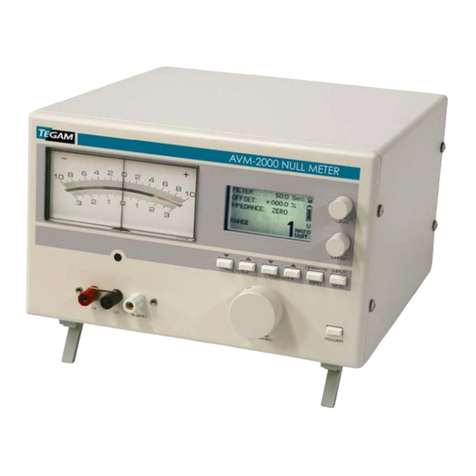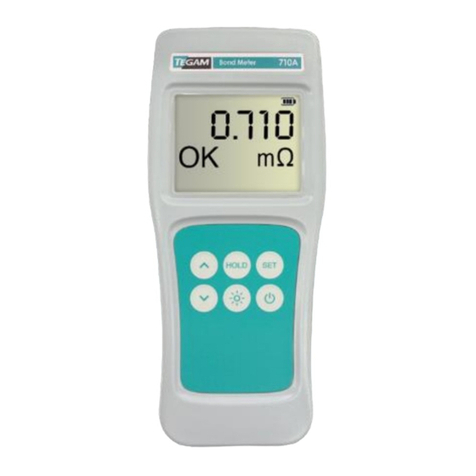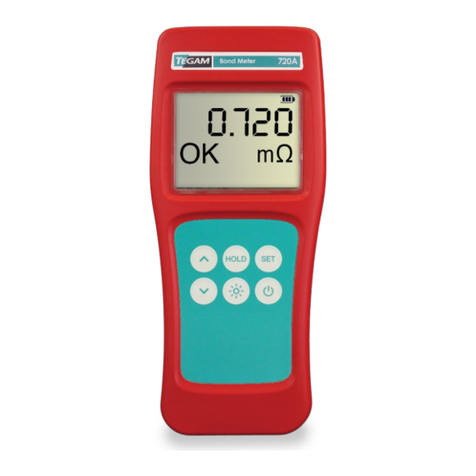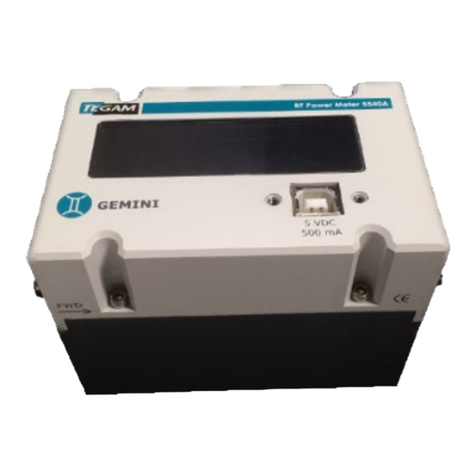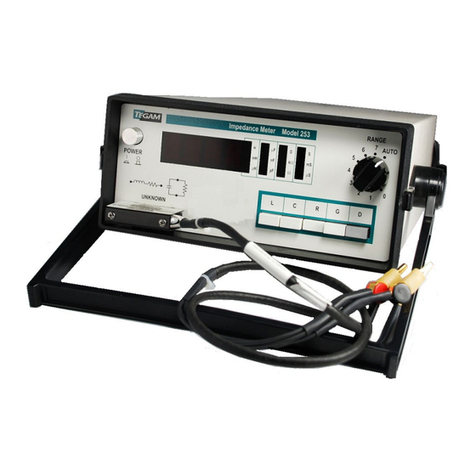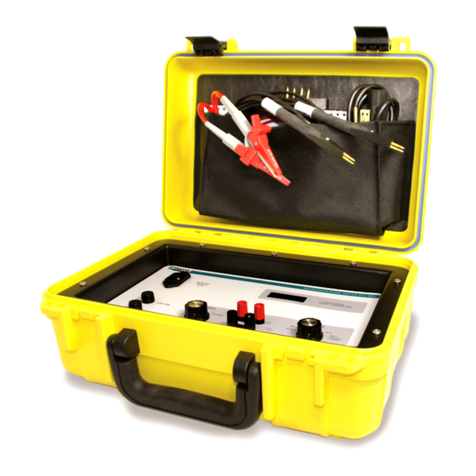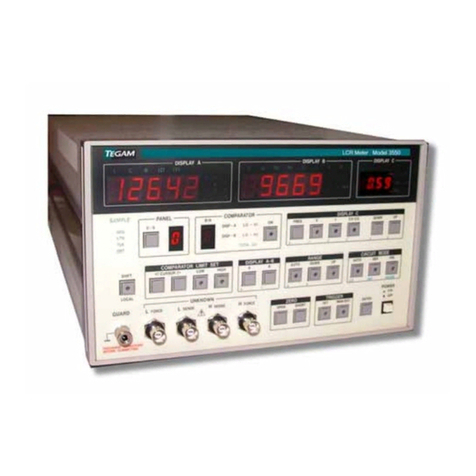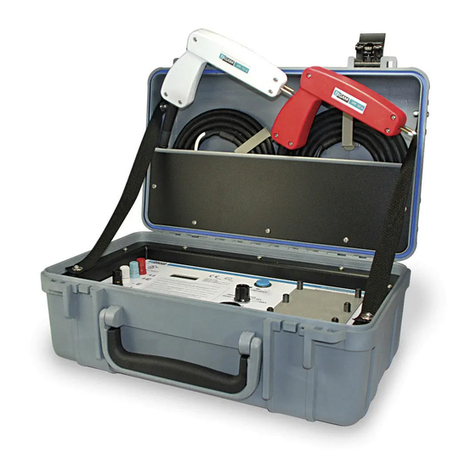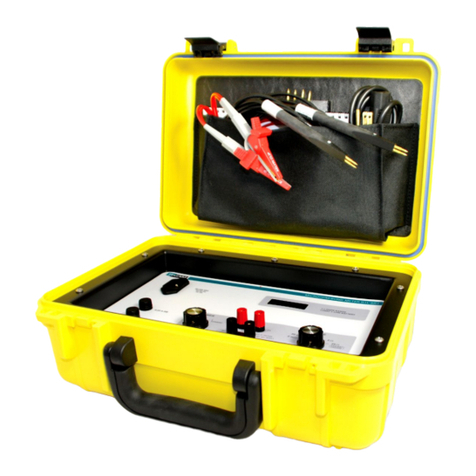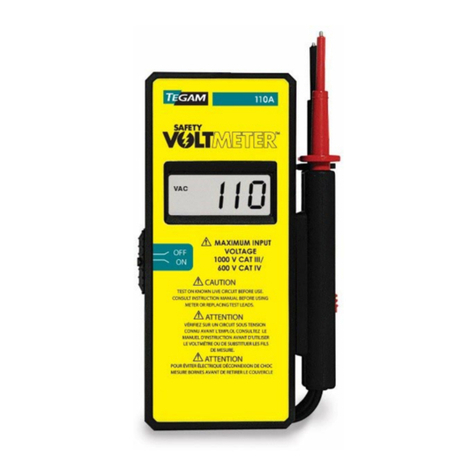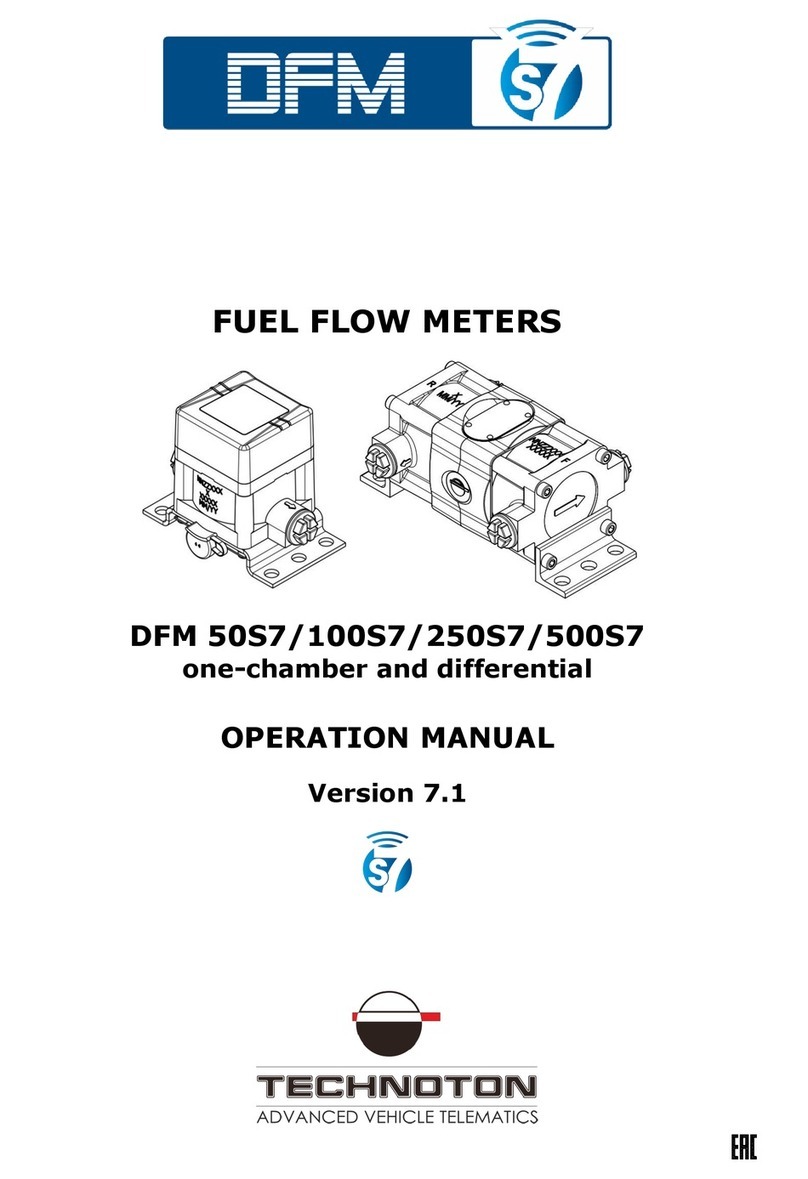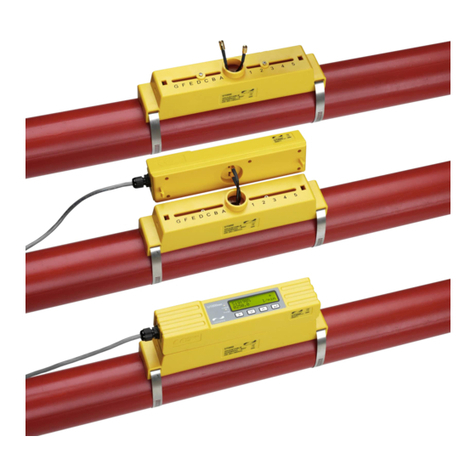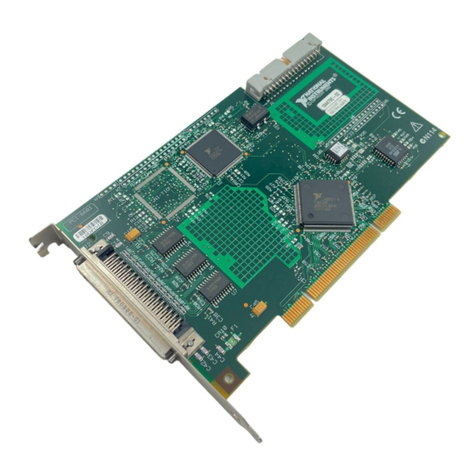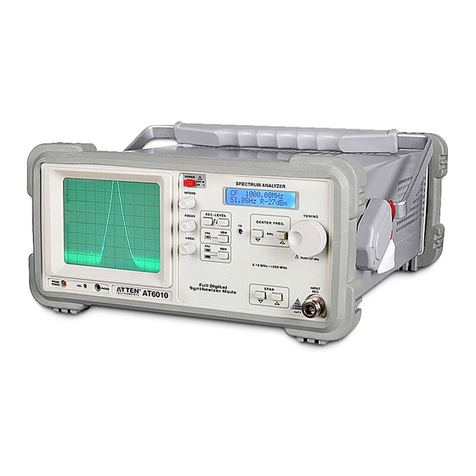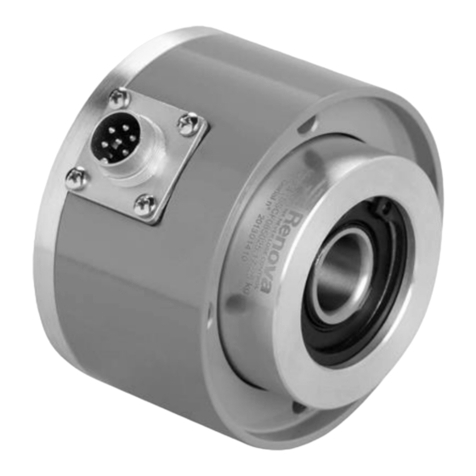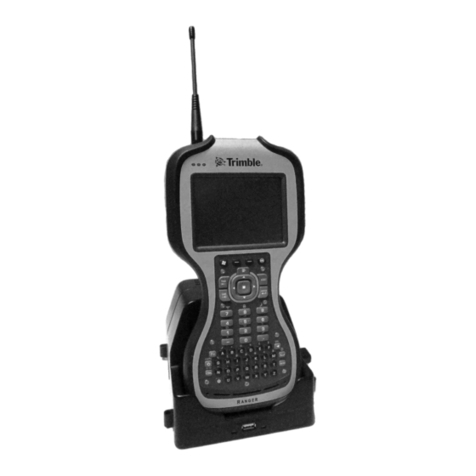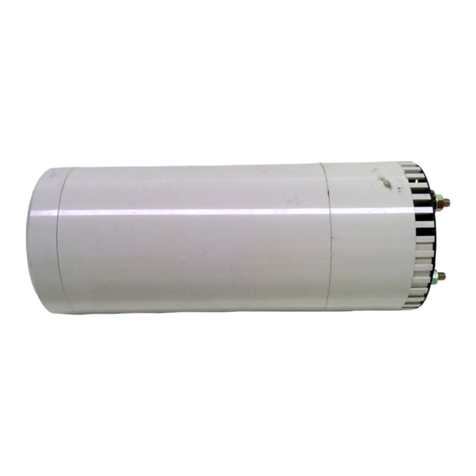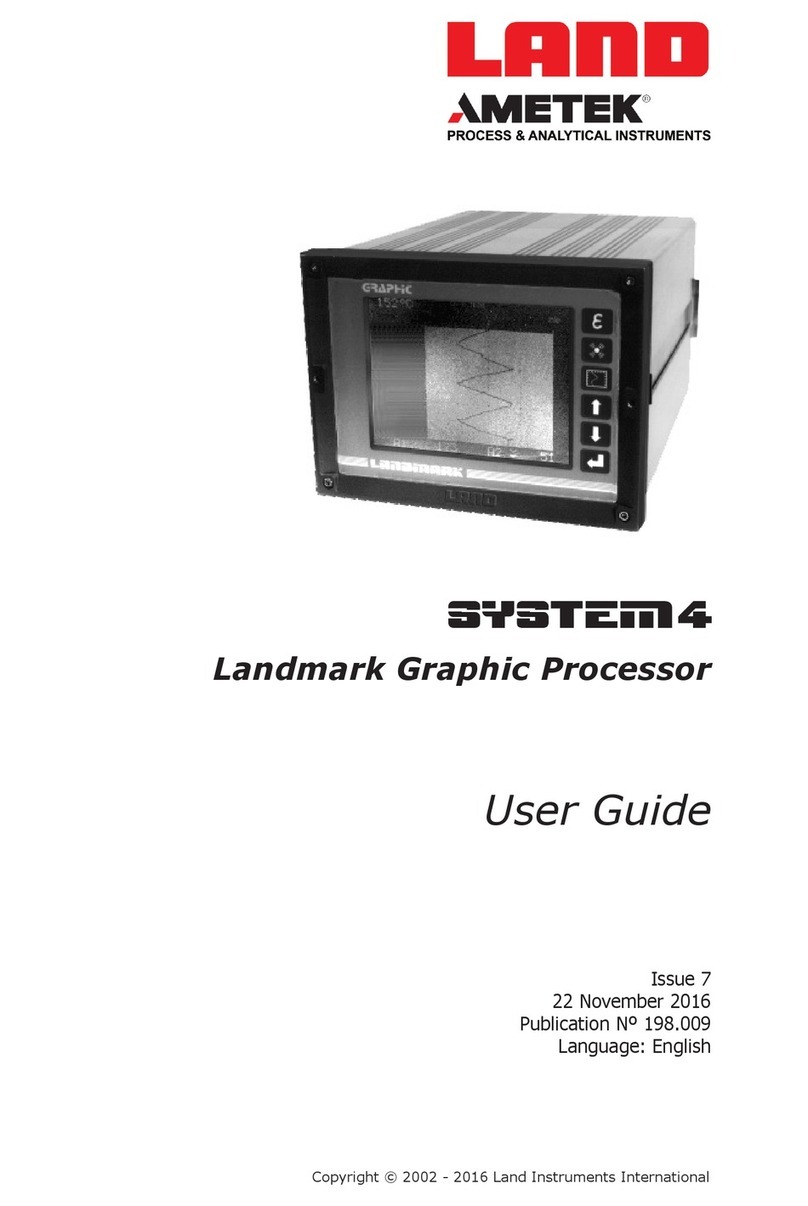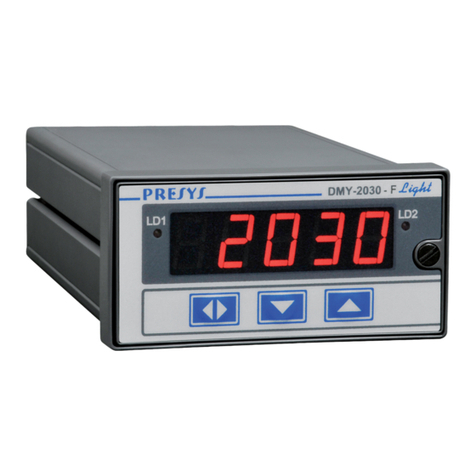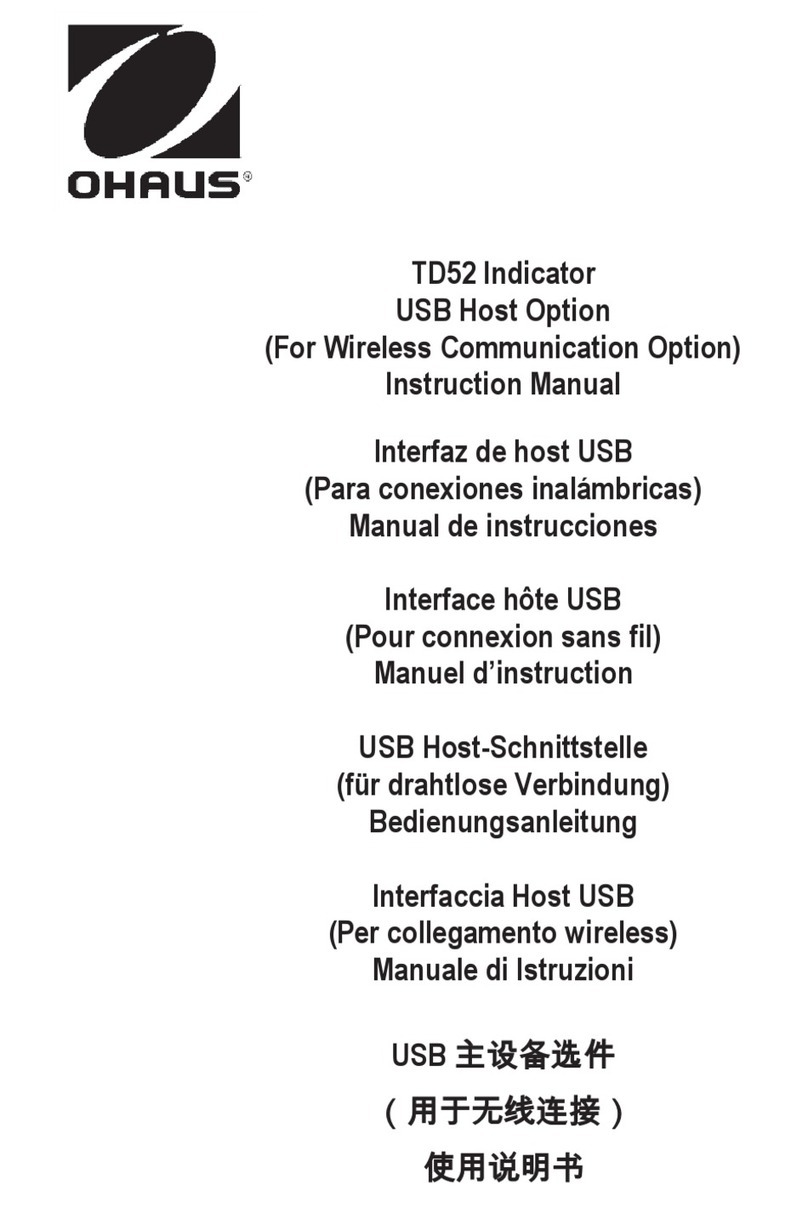Tegam R1L-BI User manual

10 TEGAM WAY • GENEVA, OHIO 44041 • 440-466-6100 • FAX 440-466-6110
• sales@tegam.com
R1L-BI/R1L-BIR
MICROOHMMETER AND
BOND TESTER
MODEL R1L-BI, R1L-BIR
Instruction Manual
PN# R1L-BI/BIR-900
Publication Date: May 2019
REV. B
REPRODUCTION AND DISTRIBUTION OF THIS TECHNICAL MANUAL IS AUTHORIZED FOR US
GOVERNMENT PURPOSES. TEGAM PROPRIETARY INFORMATION.
NOTE: This User’s Manual was as current as possible when this product was manufactured. However,
products are constantly being updated and improved. To ensure you have the latest documentation, refer
to www.tegam.com

10 TEGAM WAY • GENEVA, OHIO 44041 • 440-466-6100 • FAX 440-466-6110
• sales@tegam.com
TABLE OF CONTENTS
TABLE OF CONTENTS
1. INSTRUMENT DESCRIPTION
Introduction .........................................................1-1
Performance Characteristics Table 1, Figure 1...........1-1
Description of Equipment .......................................1-2
Figure 2a, 2b: Front Panel Controls......................1-4
List of Items Furnished ..........................................1-6
Storage and Shipping Requirements ........................1-6
Safety Information and Precautions .........................1-6
2. PREPARATION FOR USE AND INSTALLATION
Unpacking and Inspection ......................................2-1
Preparation for Use................................................2-1
3. OPERATING INSTRUCTIONS
Rotary Switch Functions.........................................3-1
General Theory of Operation...................................3-2
4. PRINCIPLES OF OPERATION
Principles of Operation ...........................................4-1
5. MAINTENANCE
Inspection ............................................................5-1
Cleaning ..............................................................5-1
Calibration ...........................................................5-2
Troubleshooting ....................................................5-6
Table 2: Fault Symptoms and Repair Actions ........5-6
Preparation for Shipment .......................................5-7
Overhaul Instructions ............................................5-8
Figure 3: Parts Layout........................................5-9
Figure 4, 5: Digital, Analog Section.................... 5-10
Table 3: Parts List – Main Board Assembly.......... 5-12
Table 4a, 4b: Parts List – Final Assembly............ 5-15
Table 5a, 5b: Parts List – Front Panel Assembly .. 5-16
Table 6: Parts List – Battery Board Assembly ...... 5-20
Table 7: Vendor Cage Code Directory................. 5-21
6. SERVICE INFORMATION
Preparation for Repair or Calibration Service.............6-1
Expedite Repair and Calibration Form ......................6-2
Warranty..............................................................6-3

10 TEGAM WAY • GENEVA, OHIO 44041 • 440-466-6100 • FAX 440-466-6110
• sales@tegam.com
1-1
INSTRUMENT DESCRIPTION
SECTION 1
INSTRUMENT DESCRIPTION
1.1 Introduction
The Model R1L-BI/R1L-BIR is a digital Microohmmeter / Bond
Tester with full scale ranges from 2 mΩ to 20 Ω. The
instrument utilizes the four-terminal, Kelvin technique to
eliminate errors caused by the resistance of the leads. The
resistance reading is displayed on a 3½ digit liquid crystal
display on the front panel. An over-range condition is indicated
as a "1" followed by three blank digits (the decimal point is also
displayed in its normal position for the range selected).
Model R1L-BIR is electronically identical to model R1L-BI, but
it has a rugged case as the enclosure rather than an open front
panel.
1.2 Performance Characteristics
This is a range-selection instrument, with a rotary 5 range
selector switch.
Range
Full
Scale
(Ω)
Resolution
(Ω)
Test
Current
Peak
(A)
1
1.999 m
1 µ
1.4
2
19.99 m
10 µ
140 m
3
199.9 m
100 µ
14 m
4
1.999
1 m
1.4 m
5
19.99
10 m
140 µ
Reactive loads not to exceed 2mH or 100µF with a minimum of
5µΩ per µH of series resistance. See figure 1 below.
Table 1: Specifications

10 TEGAM WAY • GENEVA, OHIO 44041 • 440-466-6100 • FAX 440-466-6110
• sales@tegam.com
1-2
INSTRUMENT DESCRIPTION
Figure 1
Accuracy:
Accuracy on all ranges: ± (0.25% of reading + 1 count), when
powered from the batteries only.
1.3 Description of Equipment
Physical: The R1L-BI circuitry is enclosed in a bench top case,
while the R1L-BIR circuitry is enclosed in a rugged portable
case.
Dimensions:
R1L-BI: 101 mm (4”) x 292 mm (11.5”) x 203 mm (8”).
Weight is 1.6 kg (3.6 lb).
R1L-BIR: 127 mm (5”) x 254 mm (10”) x 228 mm (9”). Weight
is 3 kg (6.7 lb).
Controls and connectors are of a size and spacing such that
the instrument may be operated while wearing safety gloves.
Electrical: The R1L-BI/R1L-BIR is powered by an internal
battery consisting of three rechargeable NiCad ‘C’ cells (2800
mAh - 3500 mAh) with a built-in charger. Input power for the
charger is 90 to 250 VAC at 50 Hz or 60 Hz. Charging power
is supplied via a removable line cord; one end of which plugs
into a line filter on the front of the R1L-BI/R1L-BIR, and the
other end being a standard three-pin grounded line plug.

10 TEGAM WAY • GENEVA, OHIO 44041 • 440-466-6100 • FAX 440-466-6110
• sales@tegam.com
1-3
INSTRUMENT DESCRIPTION
Fuse: ¼ A 3AG Slow blow, TEGAM PN#FU-202
Input Protection: The R1L-BI/R1L-BIR will not be damaged by
a signal of 1 Vp-p applied across any pair of input terminals.
Environmental: This unit will operate over a temperature
range from 0 °C to 50 °C, 75% RH non-condensing, up to
3050 m altitude.
Front Panel Controls and Displays (See figures 1a and 1b)
RANGE Switch. The rotary 5 range selector switch may be used
to step through all five ranges.
POWER Switch. Used to turn the power on or off to the
instrument.
DISPLAY is a 3 ½ digit, displaying readings from 1.999 to
199.9.
Four binding posts for connection of test leads are marked +I,
+E, -E, and -I. Proper connections to the resistor under test
are described in Section 3.2 below.

10 TEGAM WAY • GENEVA, OHIO 44041 • 440-466-6100 • FAX 440-466-6110
• sales@tegam.com
1-6
INSTRUMENT DESCRIPTION
1.4 List of Items Furnished
1 each Model R1L-BI/R1L-BIR with power cord
3 each rechargeable NiCad battery cells (P/N: BA-110)
2 each Kelvin Clip Cables, one end with a dual banana plug
and the other end with a gold plated Kelvin clip (P/N:
KTL-100) (only included with the R1L-BI)
1 each R1L-BI/R1L-BIR Instruction Manual (P/N: R1L-
BI/BIR-900-01)
1.5 Storage and Shipping Requirements
Standard precautions which apply to electronic test
instruments should be followed. Care should be taken to
prevent damage to associated cables.
Remove the battery cells for inactive storage of 30 days or
more.
Temperature: -40 °C to +71 °C.
Relative humidity: 0 to 100%, non-condensing.
Altitude: 4570 m
See Section 5.7 below for shipping requirements.
1.6 Safety Information and Precautions
Grounding the Equipment
This product is grounded through the grounding
conductor of the power cord. To avoid electrical shock or
other potential safety hazards, plug the power cord into a
properly wired receptacle before using this instrument.
The proper grounding of this instrument is essential for
safety and optimizing instrument operation.
Danger Arising from Loss of Ground
If the connection to ground is lost or compromised while
charging the batteries, a floating potential could develop
!

10 TEGAM WAY • GENEVA, OHIO 44041 • 440-466-6100 • FAX 440-466-6110
• sales@tegam.com
1-7
INSTRUMENT DESCRIPTION
in the instrument. Under these conditions all accessible
parts, including insulating parts such as knobs and
terminals could develop a hazardous voltage and put the
user at risk.
Use the Proper Fuse
To avoid fire hazard, use only the correct fuse type as
specified for the AC power supply in the “Description of
Equipment” or “Maintenance” sections of this manual.
Do Not Use in Explosive Environments
The R1L-BI/R1L-BIR microohmmeter is not designed for
operation in explosive environments.

10 TEGAM WAY • GENEVA, OHIO 44041 • 440-466-6100 • FAX 440-466-6110
• sales@tegam.com
2-1
PREPARATION FOR USE AND INSTALLATION
SECTION 2
PREPARATION FOR USE AND INSTALLATION
2.1 Unpacking and Inspection
Upon receipt, the R1L-BI/R1L-BIR and accessories should be
carefully unpacked and removed from the shipping container.
Separate the units from the packing material and inspect both
the instrument and the accessories (if any) for any external
damage.
•If any dents, broken, or loose parts are seen, do not use the
equipment. Notify TEGAM immediately.
•Check that all items are present. If any items are missing,
notify TEGAM immediately.
2.2 Preparation for Use
Battery Installation
Note that the instrument is shipped with its battery removed.
Unwrap the 3 cells which comprise the battery.
Be sure the power line cord is disconnected. Check that the
Power Switch is in the OFF position. Remove the four screws
at the corners of the R1L-BI/R1L-BIR’s top (control/display)
panel. Carefully lift the unit out of its cabinet. Place the unit
upside down on a surface which will not mar or damage the
control/display panel.
WARNING
DO NOT CONNECT THE AC LINE CORD PRIOR TO REMOVING
THE UNIT FROM IT
S CASE OR WHILE THE UNIT IS OUT OF
ITS CASE, OR ELSE THE MAINS VOLTAGE WILL PRESENT A
POSSIBLE SHOCK HAZARD.
CAUTION
BE SURE TO OBSERVE THE PROPER POLARITY WHEN
INSERTING THE BATTERY CELLS OR DAMAGE MAY RESULT.

10 TEGAM WAY • GENEVA, OHIO 44041 • 440-466-6100 • FAX 440-466-6110
• sales@tegam.com
2-2
PREPARATION FOR USE AND INSTALLATION
For R1L-BI units only, remove the two screws that secure the
battery retention plate.
Insert the battery cells, one at a time, in accordance with the
polarity indications marked on both the battery cell and the
battery holder. Insert the positive end of the battery cells
first.
After installing the cells, reinstall the plate (for R1L-BI only),
reinstall the instrument in its case, and secure the four corner
screws.
Power Up
Plug the power cord into the R1L-BI/R1L-BIR front panel
receptacle, and plug the other end into a standard AC outlet.
For battery operation (with charged battery cells), this step is
omitted. Turn on the POWER rotary switch. Note that this
switch turns on both line and battery power.
Charging the Battery Cells
Prior to battery operation, it is recommended the R1L-
BI/R1L-BIR Microohmmeter be plugged into AC power for at
least 14 hours to charge the battery cells. To charge the
battery cells, the Power Switch must be turned ON, and the
Range Switch should be set to 20 Ω. With the Range Switch
set to lower ranges, the charge rate decreases and the
batteries will be discharged, especially on the 2 mΩ range,
even with no resistance connected to the instrument.
(However, the discharge rate in this range will permit
operation for at least 14 hours with no resistance connected.)
WARNING
ALTHOUGH THE FRONT PANEL IS NORMALLY GROUNDED
VIA THE GROUND PIN OF THE POWER CABLE, IF THIS
CONNECTION IS FAULTY AND IF THE HIGH SIDE OF THE
POWER CABLE IS SHORTED TO THE
PANEL, THE PANEL
COULD POSSIBLY HAVE MAINS VOLTAGE ON IT
; SO DO
NOT TOUCH THE PANEL WHEN AC POWER IS CONNECTED.

10 TEGAM WAY • GENEVA, OHIO 44041 • 440-466-6100 • FAX 440-466-6110
• sales@tegam.com
3-1
OPERATING INSTRUCTIONS
SECTION 3
OPERATING INSTRUCTIONS
Use the cables connecting their banana plug terminations to
the four binding posts marked +I, +E, -E, and -I.
WARNING
DO NOT TOUCH THE BINDING POSTS WHEN THEY ARE
CONNECTED TO EXTERNAL CIRCUITS. LETHAL
VOLTAGES MAY BE PRESENT AT THESE POSTS.
3.1 Rotary Switch Functions
Operation of the Model R1L-BI/R1L-BIR is extremely simple.
There are only two switches.
The RANGE rotary switch manually scrolls through the five
ranges.
Full scale on any range may be described as 2,000 (actually
1,999), since this is a 3½ digit meter. If the readings are
exceeding 1,999 counts, step to the next higher range. If the
readings are less than 2,000 counts, step down a range, so
that it will read 1,999 counts, or less. The decimal point is
located automatically for the correct reading.
If the selected range is too low for the value of the resistor
under test, the display will show over-range.
The POWER rotary switch turns on the power to operate the
unit or turns off the power to the unit. The appearance of the
display will show that power is on; absence of the display
indicates that either power is off, batteries are discharged, or
there is some malfunction. Note that when power is turned
off, it may take several seconds to discharge circuit capacity
to completely blank the display. The black markings seen have
no effect and disappear when power is turned back on.

10 TEGAM WAY • GENEVA, OHIO 44041 • 440-466-6100 • FAX 440-466-6110
• sales@tegam.com
3-2
OPERATING INSTRUCTIONS
3.2 General Theory Of Operation
Measurement Principle
A 4-terminal measurement method is used to determine the
resistance of the item under test. This method allows the
accurate measurement of low values of resistance in spite of
the other resistances present in the connection leads. A known
current is supplied to the item under test via two wire leads
connected to the +I and -I binding posts on the R1L-BI/R1L-
BIR Microohmmeter front panel. Two other wire leads
connected to the +E and -E binding posts on the R1L-BI/R1L-
BIR front panel sense the voltage developed across the
resistance under test due to the supplied known current. The
R1L-BI/R1L-BIR then calculates the resistance of the item
under test utilizing Ohm's law, and displays it on a 3 ½ digit
display.
Kelvin Klip Cable Description
A Kelvin clip consists of two opposing jaws of an alligator style
clip which are insulated from each other, so one jaw may be
used to connect a source of current to the resistance under
test, and the other jaw used to measure the voltage at the test
point. The two jaws are spring loaded to clamp onto a cylinder
of ½ inch diameter or less.
WARNING
OPERATING THE R1L-BI/R1L-BIR MICRO
OHMMETER AND
TAKING RESISTANCE MEASUREMENTS ON A POWERED OR
ENERGIZED COMPONENT COULD CAUSE SERIOUS HARM
TO THE OPERATOR AND/OR DAMAGE THE INSTRUMENT.
BE SURE THE ITEM TO BE MEASURED IS DISCONNECTED
FROM OTHER COMPONENTS AND APPARATUS.
If the battery cells have not been installed, refer to section
2.2.Battery only operation will result in the most stable and
accurate readings. The R1L-BI/R1L-BIR may be operated

10 TEGAM WAY • GENEVA, OHIO 44041 • 440-466-6100 • FAX 440-466-6110
• sales@tegam.com
3-3
OPERATING INSTRUCTIONS
while charging the batteries, however it will not conform to
specifications in this configuration.
NOTE: The amount of current available for charging the
battery decreases as lower resistance ranges are selected. In
the 2 mΩrange, the current supplied to the resistance under
test exceeds the charging current, and the battery will be
drained.
To obtain the best accuracy, allow the R1L-BI/R1L-BIR to
warm up for 15 minutes on the 20 Ωrange before making
measurements. Even if in battery operation, this will not cause
appreciable battery discharge.
Using the Kelvin-Clip cables
Plug one Kelvin-Clip cable dual banana plug across the +E and
+I binding posts, and plug the other Kelvin-Clip cable dual
banana plug across the -E and -I binding posts. Note that in
both cases, the small "I" marked on the dual banana plug
should go into the respective I binding post.
If Kelvin-Clip cables are not used, a pair of shielded cables
may be utilized. As occurs in the Kelvin-Clip cables in the
above paragraph, one cable should have its shield connected
to the “+I” binding post and its center conductor connected to
the +E binding post. Similarly, the other cable should have its
shield connected to the -I binding post and its center
conductor to the -E binding post. It is also recommended that
the resistance of the cables should not exceed 350
mΩ/conductor.
NOTE: Particularly in the 2 mΩrange, where a test current of
approximately 1.4 A is used, excessive lead resistance will
prevent an accurate measurement.
Set the Range Switch to the desired measurement range and
read the resistance on the liquid crystal display. If the
resistance is higher than the selected range, the display will
show a "1" and three blank digits, indicating over-range. The

10 TEGAM WAY • GENEVA, OHIO 44041 • 440-466-6100 • FAX 440-466-6110
• sales@tegam.com
3-4
OPERATING INSTRUCTIONS
decimal point will also appear in the proper location for the
selected range.
After prolonged operation on battery power, when the battery
voltage approaches the end of its useful range, the "LO BAT"
indicator will be seen on the display. Although the battery cells
are not fully discharged and they will not be damaged by
additional use, this is a warning to the operator that the
battery cells need to be charged.
Use of HTP-100 probes with the R1L-BI/R1L-BIR:
1. Connect the BLUE spade lug from the LEFT HTP-100 Probe
to the RED E+ terminal of the R1L-BI/R1L-BIR.
2. Connect the RED spade lug from the LEFT HTP-100 Probe
to the RED I+ terminal of the R1L-BI/R1L-BIR.
3. Connect the WHITE spade lug from the RIGHT HTP-100
Probe to the BLACK E- terminal of the R1L-BI/R1L-BIR.
4. Connect the BLACK spade lug from the RIGHT HTP-100
Probe to the Black I- terminal of the R1L-BI/R1L-BIR.
5. Hold the RED HTP-100 Probe in your left hand and the
WHITE HTP-100 Probe in your right hand, and push the
probe points against the surface to be measured with
sufficient force to cause the points to retract slightly.

10 TEGAM WAY • GENEVA, OHIO 44041 • 440-466-6100 • FAX 440-466-6110
• sales@tegam.com
4-1
PRINCIPLES OF OPERATION
SECTION 4
PRINCIPLES OF OPERATION
Power Supply
The internal switching power supply U8 accepts nominal line
voltages between 90 and 250 VAC 50/60 Hz, allowing
operation worldwide. C1, C2, U1, R1, R2 and R101 form a
constant current regulator set to approximately 758 mA for
charging the battery. D5 is used to isolate the AC power for
the battery. D7 serves to clamp the voltage to less than 5 V
when the battery is disconnected. The negative 3.6 volt power
supply for U2 and U10 is developed by U5.
Test Current Path
The test current used to perform the resistance measurement
originates from the battery + terminal connected to the +3.6
V power symbol at the emitter of Q1. It flows through Q1 into
the COM1 terminal of SW1 and out of the terminal selected by
the switch for the measurement range chosen. Each pole of
the COM1 section of SW1 is connected to a different tap on
the current sensing resistor string made up of R13, R48, R50,
R52 and R54. The test current flows into the sense resistor
string at the tap selected, out of R54 into D3 and out of D3 to
the I+ test jack. The external test leads conduct the current
through the resistance being measured and back to the I- test
jack, where it returns to ground and then to the battery -
terminal.
Test Current Regulator
The test current is controlled to a constant value for each
range with a feedback loop. The main loop amplifier is U9A.
The output of U9A controls the conduction of Q1 using Q2,
such that if the output voltage of U9A increases, the test
current increases. The inputs of U9A compare the voltage
across the current sensing resistor string with a 3 volt
reference voltage produced by U4, the voltmeter IC. The
voltage across the sensing resistor string is maintained at 1.5
V, half the value of the reference voltage because R9 and R11

10 TEGAM WAY • GENEVA, OHIO 44041 • 440-466-6100 • FAX 440-466-6110
• sales@tegam.com
4-2
PRINCIPLES OF OPERATION
are twice the value of R8 and R9. The reference voltage of 3
V is present between the VREF signal at one end of R9 and the
+3.6 V power supply present at one end of R11. The voltage
at one end of the sensing resistor string is present at U11A
pin 1 which feeds R8. The voltage at the other end of the
sensing resistor string is present at U11B pin 7 which feeds
R10. U11A and U11B are very high input impedance buffer
amplifiers which sense the voltage across the current carrying
portion of the sensing resistor string without causing errors in
the test current. R127, R129 and CR1 provide overvoltage
input protection for pin 3 of U11A, and similarly R46, R128
and CR2 for U11B. U2B will shut off the current source if the
voltage on the I+ binding post becomes less than about -3 V.
Test Current Adjustment
The test current on the 2 milliohm range is 1.4 amps. It is
very stable, but not adjustable. The 1.4 A current stability is
determined by the stability of R54, the 3 V reference
developed by U4 and to a minor extent other circuit
components. The test currents on the four other ranges are
adjusted to approximately 1/10, 1/100, 1/1000 and 1/10000
of the actual value of the 2 milliohm range test current during
the calibration/ adjustment process. Trimpots R53, R51, R49
and R114 are used for this adjustment, and are adjusted
sequentially in that order. Adjusting the current affects the
readings, so current adjustment INDEPENDENT of the
readings adjustment is not possible.
Voltage Measurement
The voltage across the resistance being measured is amplified
by U10A, U10B and U9B. The E+ and E- test jacks are the
input to this differential amplifier, and the output is connected
to the voltmeter IC U4 pins 38 and 39. R130, R131, R141,
R142, CR3 and CR4 provide overvoltage input protection.
U10A, U10B, R132, R133 and R134 provide a differential gain
of 5: the voltage between U10A pin 1 and U10B pin 7 is 5
times the voltage between E- and E+. U9B provides voltage
gain of 10, and develops its output between VREF at pin 40 of
U4 and VIN+ at pin 39 of U4. An adjustable bipolar offset
voltage is added to this output by R143 before it is applied to

10 TEGAM WAY • GENEVA, OHIO 44041 • 440-466-6100 • FAX 440-466-6110
• sales@tegam.com
4-3
PRINCIPLES OF OPERATION
VIN- at pin 38 of U4. C18 and 140 are a low pass filter to
reduce noise.
The voltmeter IC U4 converts the amplified voltage across the
resistance being measured into a displayed reading. Because
the test current is precisely regulated along with the various
gains chosen in the circuit, the displayed value is directly
proportional to the resistance being measured. U4 develops a
reference voltage of 3 V between pins 8 and 40. The reference
is divided by the resistor string R31, R32, R146 and R143.
R146 provides an adjustable voltage used as the analog to
digital conversion reference to pin 44. R143 provides an
adjustable zero reading.
Display
U4 directly drives the LCD, except for the decimal points and
the LOBAT indicator. The decimal point associated with the
range selected is displayed when the range switch SW1
provides a +3.6 V signal to one of the inputs of U7. The LOBAT
signal is displayed when U2A detects the voltage at pin 40 of
U4 falls below ground. Since this pin is maintained by U4 at
the reference voltage of 3 V below the battery voltage, LOBAT
will be displayed when the battery is less than approximately
3 V.

10 TEGAM WAY • GENEVA, OHIO 44041 • 440-466-6100 • FAX 440-466-6110
• sales@tegam.com
5-1
MAINTENANCE
SECTION 5
MAINTENANCE
5.1 Inspection
These units should be inspected semi-annually. Cables should
be periodically inspected to make sure they are in good
condition. Check that the switches turn smoothly. Check all
four binding posts to ensure that they operate smoothly.
No other maintenance is required, other than to keep the
battery charged through power line operation. Charging
should be done for at least 14 hours after long periods
(several months) of storage or after considerable use on
battery power.
5.2 Cleaning
The instrument should be cleaned periodically, as is
necessary, using mild soap and a damp cloth, followed by a
second damp rinsing cloth.
Clean the LCD window using a soft cloth moistened with water
or "Windex" type window cleaner. DO NOT use common paper
towel products as some brands may contain fibers which could
scratch the display window. DO NOT apply significant pressure
to the LCD as it could separate from the front panel. DO NOT
use alcohol, solvents, or harsh chemicals to clean the LCD
window.
5.3 Test Equipment and Tools Required for Calibration and
Repair
Calibration of the R1L-BI/R1L-BIR is recommended on a
yearly basis, and is done at a temperature of 23 °C ± 1 °C.
To obtain best results, keep the unit at 23 °C ± 1 °C for at
least 8 hours, and allow it to warm up for 30 minutes before
making any adjustments.

10 TEGAM WAY • GENEVA, OHIO 44041 • 440-466-6100 • FAX 440-466-6110
• sales@tegam.com
5-2
MAINTENANCE
Precision four terminal resistors with accuracy of 0.05% or
better: 1 mΩ, 1.9 mΩ, 19 mΩ, 190 mΩ, 1.9 Ω, and 19 Ω
A standard 4 ½ digit digital voltmeter: with 2 V range,
accuracy better than 0.03% of reading ±1 count.
Screwdrivers: Medium Phillips and small slotted for trim-pot
adjustment.
Three 20 AWG approximately 4 inch long Buss Wires
Four 18 AWG Wires (or dual wire cable) approximately 2 feet
long with clips
5.4 Calibration
CAUTION
SAFETY PRECAUTIONS MUST BE TAKEN WHEN HANDLING
THIS INSTRUMENT WHEN THE LINE CORD IS PLUGGED IN
AND THE R1L-BI/R1L-BIR
HAS BEEN REMOVED FROM ITS
CASE, TO ENSURE THAT CONTACT IS NOT MADE WITH THE
AC POWER CONNECTIONS OR OTHER POTENTIALLY
HARMFUL POINTS. FAILURE TO OBSERVE PROPER SAFETY
PRECAUTIONS MAY CAUSE SERIOUS HARM TO THE
OPERATOR AND/OR DAMAGE THE INSTRUMENT.
A. Preparation
1. Remove the front panel assembly from the case by
removing the four retaining screws. Retain the four
screws for reinstallation.
2. Install a new set of approved batteries into the UUT
as required. Observe polarity.
3. Plug UUT in and turn on setting the range switch to
20 Ωrange, allow a 14 hour charge time. (Skip this
step if batteries have already been charged.)
4. After the UUT has been charged, unplug the UUT.
5. Allow a 10 minute COOL DOWN.
This manual suits for next models
1
Table of contents
Other Tegam Measuring Instrument manuals
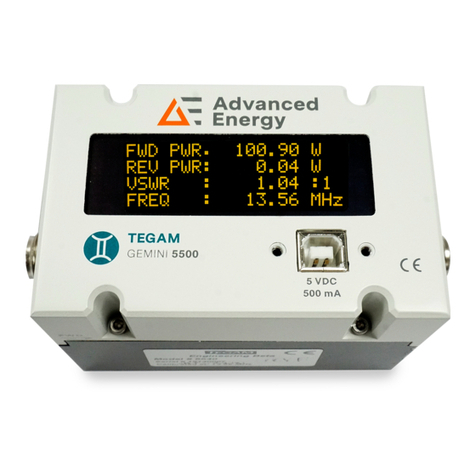
Tegam
Tegam Advanced Energy GEMINI 5540A User manual
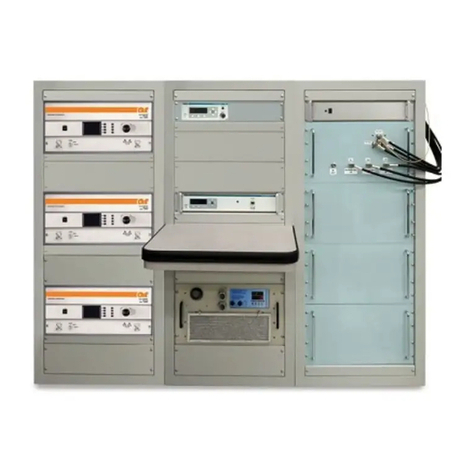
Tegam
Tegam 1316A User manual

Tegam
Tegam 720A User manual
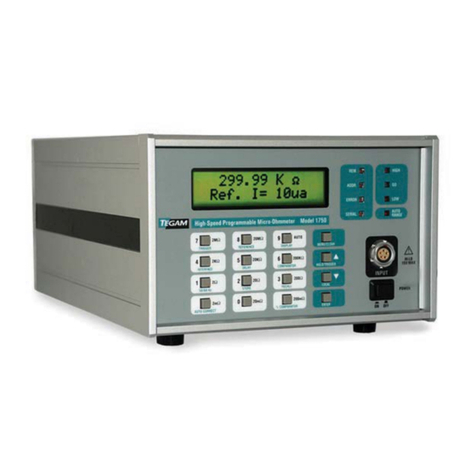
Tegam
Tegam 1750 User manual
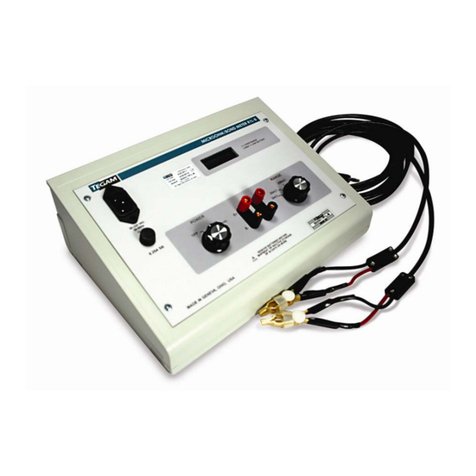
Tegam
Tegam R1L-B User manual
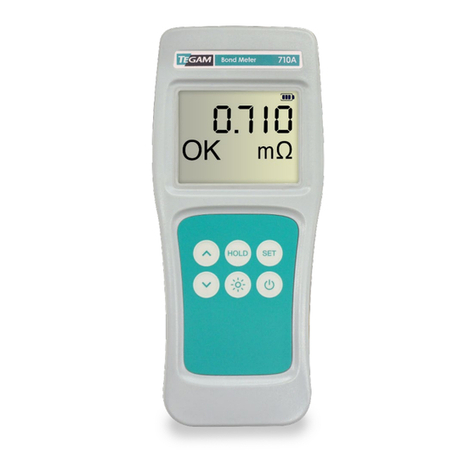
Tegam
Tegam 710A User manual
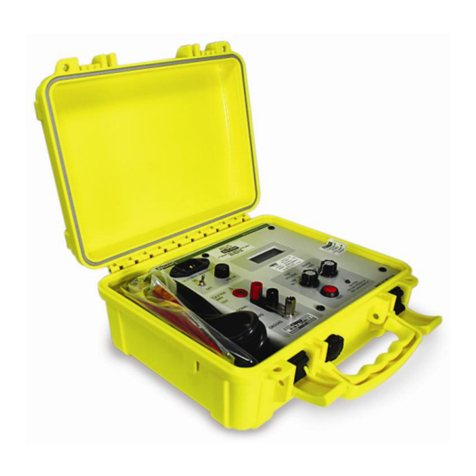
Tegam
Tegam R1M-A User manual
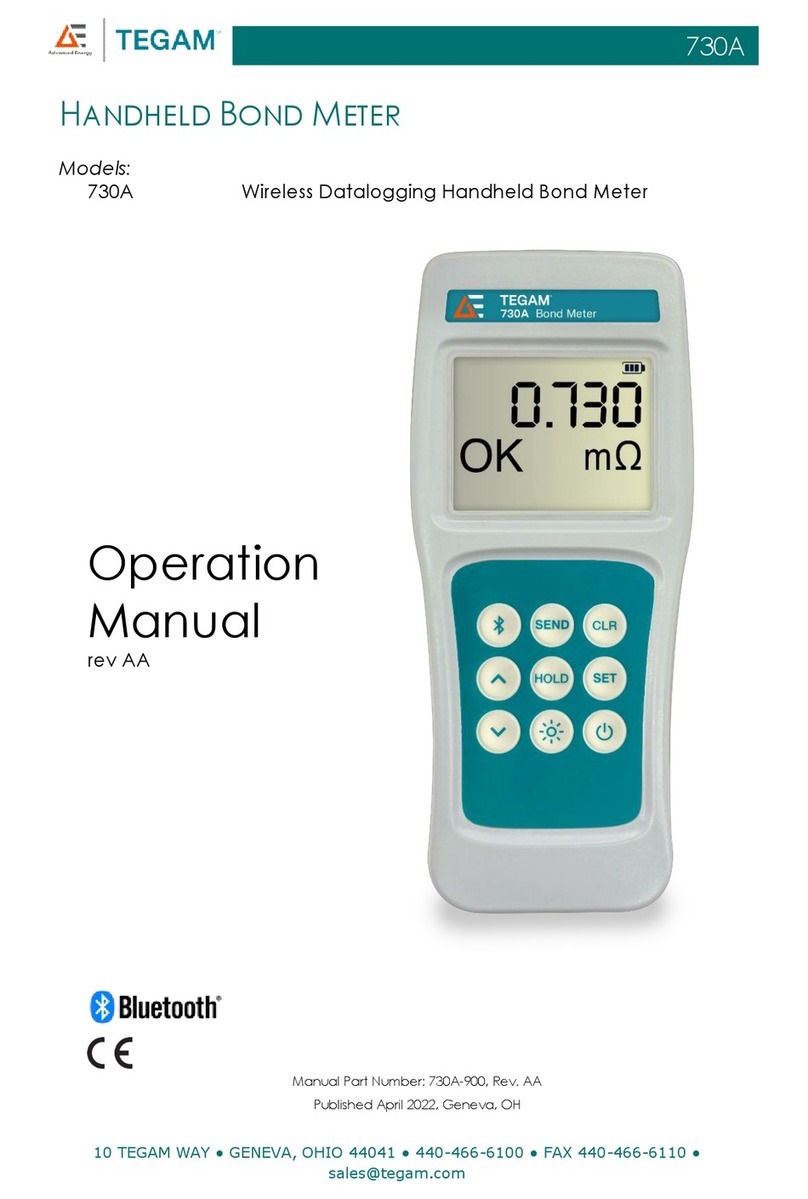
Tegam
Tegam 730A User manual

Tegam
Tegam GEMINI 5541A User manual

Tegam
Tegam 1806 User manual





